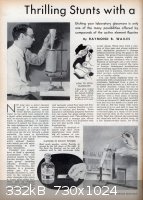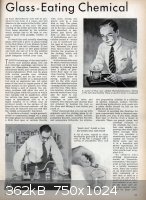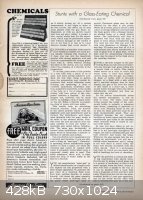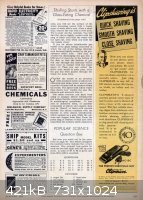| Pages:
1
2 |
Polverone
Now celebrating 21 years of madness
        
Posts: 3186
Registered: 19-5-2002
Location: The Sunny Pacific Northwest
Member Is Offline
Mood: Waiting for spring
|
|
Hydrofluoric acid
Seeing as acids are a popular topic right now... I want to share my attempt to make hydrofluoric acid. Now, HF gives me the willies. It's a *really*
dangerous substance. But one day this week I felt like trying to make it. So I took ceramic-grade calcium fluoride (fine powder) and put it in an
ordinary soda-glass test tube with concentrated sulfuric acid. This I heated outdoors in full safety gear, always dancing around to keep the wind at
my back. Various sources indicate that HF is prepared by heating sulfuric acid and calcium fluoride together at ~300 C. I maintained the sulfuric at a
boil for a considerable time, with very dense white fumes coming from the mouth of the tube, but I am not sure I really prepared HF. Afterward, I
cleaned the tube and it appeared completely unharmed. I was under the impression that hydrofluoric acid would rapidly attack glass.
Perplexed, I placed some "Whink" rust remover (3% HF) in a similar test tube and left it for 24 hours. Not a mark on the tube. I tried heating some
Whink in the tube, and there was a similar lack of results. Now I am puzzled, as I am positive that HF is used to etch glass commercially, but I have
utterly failed to do so. Perhaps it's time to visit the library.
So, any other home chemists with a bit of a death wish ever tried to make this substance? Perhaps I will try again with larger quantities (but as I
said, this makes me very nervous).
|
|
|
madscientist
National Hazard
   
Posts: 962
Registered: 19-5-2002
Location: American Midwest
Member Is Offline
Mood: pyrophoric
|
|
Hrm, strange... all I can think of for explanations are:
1) The glass might not contain enough silicon dioxide (I highly doubt this, as you said it was regular soda glass).
2) The hydrofluoric acid isn't concentrated enough to cause a rapid reaction (highly unlikely that would make that substantial of a difference).
3) The test tube is being eroded, but not in a very noticeable manner; it is becoming thinner but noticeable defining lines between eroded glass and
untouched glass have not been created.
I'm thinking that it is most likely the third. I believe the reaction for reaction of hydrogen fluoride with silicon dioxide are as follows.
SiO2 + 4HF --} SiF4 + 2H2O
I weep at the sight of flaming acetic anhydride.
|
|
|
Coen
Harmless

Posts: 10
Registered: 20-5-2002
Location: Netherlands
Member Is Offline
Mood: No Mood
|
|
Yes, this is rather strange. The reaction between CaF2 en H2SO4 is even used commercially sometimes.
Very diluted HF doesn't etch glass really fast. But I have some 40% HF, which etches it practically immediately when brought in contact with glass.
When I get my glovebox I will also try this experiment and posts results.
It's quite important for me because we want to make BF3 for nitration purposes and we need dry HF for that.
|
|
|
Polverone
Now celebrating 21 years of madness
        
Posts: 3186
Registered: 19-5-2002
Location: The Sunny Pacific Northwest
Member Is Offline
Mood: Waiting for spring
|
|
Actually, there was a followup on this experiment that I hadn't posted because nobody seemed interested. It turned out that the glass was quite
etched; I just couldn't see it at the time because of all the beads of liquid and clinging powders in the tube. Once thoroughly cleaned I could see
that the tube had been considerably etched.
If you have 40% hydrofluoric acid, can you make dry HF gas by dripping it into concentrated sulfuric acid, just as you can get dry HCl gas by dripping
hydrochloric acid into concentrated sulfuric? This seems like a simpler and safer (if any production of HF gas can really be considered safe) method
than heating sulfuric acid and CaF2 together.
|
|
|
Coen
Harmless

Posts: 10
Registered: 20-5-2002
Location: Netherlands
Member Is Offline
Mood: No Mood
|
|
Well, I guess that's possible. But I don't have very much of HF solution. It's maybe a little "cleaner" indeed as far as HF will ever be "clean" to
work with. But I need really a lot of HF so I guess I still have to use the CaF2 route.
|
|
|
PHILOU Zrealone
International Hazard
    
Posts: 2893
Registered: 20-5-2002
Location: Brussel
Member Is Offline
Mood: Bis-diazo-dinitro-hydroquinonic
|
|
solubilities are about equal for CaSO4 and CaF2!
CaF2 + H2SO4 (=equilibrium=) 2HF + CaSO4
Heating is needed to get HF since it is more volatile.
Bp is arround 20°C
Maybe heating was not strong enough or H2SO4 not concentrated enough; typically H2SO4 boils between 160 and 270°C when it is more and more
concentrated!
Better use NaF (soluble in water and in H2SO4 + heat)!
CaSO4 and NaHSO4 catches water for a better volatilisation!
40% HF corrodes fast glass, 6% doesn't even after long exposure!
Dry HF corrodes glass readily:
SiO2 + 4HF --) SiF4(g) + H2O
Better make a PTFE reactor with a cold trap to catch the liquid HF below 0°C; the lower the best! to avoid sniffing very toxic HF gas.
Pb reactor could also work, since PbSO4 is much less soluble than PbF2 that is also unsoluble; those precipitate will prevent further attack of the
H2SO4 or of the formed HF!
Avoid valuable glass reactor wasting!
PH Z
|
|
|
daryl
Harmless

Posts: 12
Registered: 21-9-2002
Location: Melbourne, Australia
Member Is Offline
Mood: No Mood
|
|
HF
I vaguly remember that anhydrous HF does not corrode glass. I think it has to be dissolved in water
|
|
|
Xenos
Harmless

Posts: 22
Registered: 29-8-2002
Member Is Offline
Mood: No Mood
|
|
I dont think it does. I read in Asimov on Chem. that a scientist in 1800s etched his glasses with HF gas. But, awhile ago, i aquired some NaF and
attempted to make HF. Here was my setup: I made, what looked like a still out of 2" copper fittings, because i read, again in Asimov, that elemental
fluorine attacks copper, and then wont attack the CuF layer. Then, not wanting HF gas floating around, i submersed the copper tube in some water, in a
PVC tube, becuase i read that HF does not attack PVC. In the copper 'still' i added some NaF and really crappy H2SO4 and heated the 'still'. Nothing
happened. When I looked inside, there was a hard, pourous residue on the bottom of the 'still', and no acid. I have a feeling the conc. of the
sulfuric acid was my biggest problem. I recently aquired some H2SO4 drain cleaner, 93%, and i would like to try again. As you can see, i attemped to
make this experiment as safe as possible, becuase HF is definatly one of the worst chemicals. So, my questions are, how is my setup and was my acid
conc. the problem?
|
|
|
daryl
Harmless

Posts: 12
Registered: 21-9-2002
Location: Melbourne, Australia
Member Is Offline
Mood: No Mood
|
|
Conc H2SO4 is one of the most useful reagents you can have. It is vastly different to dilute acid and is not used by domestic cleaners etc. You have
to buy it at a chemical supplier.
I vaguely remember that to make your own conc H2SO4 is too hard and is a PITA. It also detracts from your original purpose
|
|
|
vulture
Forum Gatekeeper
    
Posts: 3330
Registered: 25-5-2002
Location: France
Member Is Offline
Mood: No Mood
|
|
It's not hard....
Just takes some time and a shitload of energy 
You can heat any % H2SO4 to evaporate off water, since it forms an azeotrope with water at 98% which is almost impossible to distinguish from
anhydrous H2SO4 (which you're never going to get).
You'll notice when you reach 98% by the evolution of white SO3 fumes which are highly irritating.
One shouldn't accept or resort to the mutilation of science to appease the mentally impaired.
|
|
|
PrimoPyro
on fire
  
Posts: 122
Registered: 7-8-2002
Member Is Offline
Mood: No Mood
|
|
Ummm........
Excuse me, but maybe this will explain something:
Hydrogen Fluoride: A colorless liquid, HF, r.d. 0.99 m.p.-83*C b.p.19.5*C. It can be made by the action of sulphuric acid on
calcium fluoride . The compound is an extremely corrosive fluorinating agent which attacks glass. It is unlike other hydrogen halides in being a
liquid (a result of hydrogen bond formation). It is also a weaker acid than the others because the small size of the fluorine atom means that the H-F
bond is shorter and stronger. Solutions of hydrogen fluoride in water are known as hydrofluoric acid.
So yes, it is corrosive, but since the aqueous acid does not fully dissociate, is weaker in strength than the other hydrohalogen acids.
PrimoPyro
|
|
|
vulture
Forum Gatekeeper
    
Posts: 3330
Registered: 25-5-2002
Location: France
Member Is Offline
Mood: No Mood
|
|
The definition of corrosive is usually that if a chemical destroys living tissue, it is labeled as corrosive. In this way HF would be double
corrosive, since both the H+ and the very reactive F- damage tissue.
One shouldn't accept or resort to the mutilation of science to appease the mentally impaired.
|
|
|
ElliB
Harmless

Posts: 1
Registered: 20-10-2002
Location: GB
Member Is Offline
Mood: No Mood
|
|
Hydrogen Fluoride
Are somebody know the correct synthesis-way of CMNT (C7H3ClF3NO2) from HF and a chloronitrobenzene derivate ?
|
|
|
Hoffmann-LaRoche
Hazard to Self
 
Posts: 64
Registered: 10-9-2002
Location: mid-europe
Member Is Offline
Mood: No Mood
|
|
For god´s sake!!!
Is it REALLY necessary to experiment with HF??
HF is really one of the nastiest substances (hydrazine too..) known to man.
But if u really can´t live without it, notice:
IF u get HF on your skin, it is not possible to wash it away as usual, HF causes big, very painful wounds that do not heal.
If u get HF on your skin they can only cut the skin away to prevent the wound from growing.
They have to transplant some skin from your ass or your legs.
HLR
10 fingers present.
|
|
|
vulture
Forum Gatekeeper
    
Posts: 3330
Registered: 25-5-2002
Location: France
Member Is Offline
Mood: No Mood
|
|
It's worse
It will eat right through your skin straight to the bones which will be rapidly attacked followed by evolution of poisonous fluorides which, once they
are in the blood stream, cause heart failure.
The only thing that can help you is lot's of water and calciumgluconate gel.
One shouldn't accept or resort to the mutilation of science to appease the mentally impaired.
|
|
|
IrC
International Hazard
    
Posts: 2710
Registered: 7-3-2005
Location: Eureka
Member Is Offline
Mood: Discovering
|
|
"The only thing that can help you is lot's of water and calciumgluconate gel."
If you get a bad enough spill (% conc. vs body area) on your skin you need to inject liquid IV type calcium gluconate directly into the area. The gel
alone will not save your life. Fluoridation of the bones results in the need for amputation, and the loss of blood calcium combined with Mg binding
will likely stop your heart, this is especially true with inhalation of HF.
As with other acids, the onset and severity of the burn depends on the amount of hydrogen fluoride, its concentration, and the duration of contact.
Hydrogen fluoride penetrates tissues including the skin and nails and an apparently minor or mild exposure can cause a serious burn if not promptly
and properly treated. Although hydrogen fluoride solutions weaker than 50% may cause first degree burns (redness) which may not become apparent for
up to 24 hours, injuries from solutions over 20% generally induce unrelenting pain within 30-60 minutes. Hydrogen fluoride solutions stronger than 50%
cause pain within 5 - 10 minutes and tissue injury becomes apparent rapidly. This is usually manifest as redness followed within 30-60 minutes by a
paleness of the tissue proceeding to frank skin blanching and finally a subjacent bluish-black necrotic appearance. At this time, the pain is usually
intense. The skin becomes hard and leathery. As the acid is one thousand times less dissociated than hydrochloric acid, and therefore is a weak acid,
substantial quantities of the uncharged moiety can penetrate deeply into the tissues.
Tepperman (1980) reported a fatality due to severe hypocalcaemia resulted from exposure to a concentrated solution affecting only 2.5% of the total
body surface.
Most importantly, absorbed fluoride binds magnesium and calcium irreversibly resulting in hypomagnesaemia and severe hypocalcaemia, the latter of
which is the usual cause of death from cardiac disturbances. Hyperkalaemia may accompany widespread cellular injury and this can complicate
hypocalcaemia.
OK people, keep your calcium antacid tablets ready and eat them like candy just before playing with your HF, and stock up on the gluconate of course,
both liquid and gel (It helps to scavenge an epi pen to fill with the liquid).
Immediate removal from exposure and decontamination is essential. Affected areas should be flooded with water for at least 15 minutes. In cases of
serious exposure ( > 2.5% body surface area to anhydrous hydrogen fluoride; 10% body surface area to 70% hydrogen fluoride, 25% body surface area
to more dilute solutions) early calcium supplementation should be instituted. Patients with renal or cardiac failure may need close observation to
prevent hypercalcemia. Local treatment of the exposed areas of the skin are aimed at decontamination and inactivation of the fluoride ion by
complexing with calcium, magnesium, or quaternary ammonium compounds. In severe cases, aggressive support may be needed with treatment of pulmonary
oedema (inhalation), arrhythmias and hypotension (all routes of exposure). Skin burns may need local or intra-arterial injection with calcium
gluconate if water decontamination and other topical calcium (or magnesium) salts have not relieved the pain.
Monitoring of blood calcium, electrolytes, and magnesium is essential in serious exposures (Trevino et al, 1983). Arterial blood gases, and
electrocardiographic monitoring is also necessary. Blood calcium and electrolytes should be measured serially every 6 h for at least the first 24h in
severe cases. In the absence of full laboratory support, semi-quantitative analysis for calcium may be performed in urine (Sulkowitch Test). A chest
X-ray should be obtained for any suspected inhalation.
Monitoring of developing hypocalcaemia is essential. Removal or inactivation of the fluoride from the site of contact is important and absorbed
hydrogen fluoride must also be inactivated. The standard assessment should include immediate electrocardiographic monitoring of all serious exposures
and immediate assessment of serum calcium and electrolytes. This should be repeated every 6 hours for 24 hours, or as indicated by the clinical
course.
In known or suspected serious exposures, early administration of intravenous (if unavailable, oral) calcium supplementation
should be effected. In patients with normal renal function, excess calcium will be excreted; however, reports of hypercalcaemia during the course of
hydrogen fluoride treatment have been noted. Calcium gluconate, 10 ml of a 10% solution may be given intravenously over several minutes with 1000 mg
in 1L of 5% dextrose solution over several hours. With known or suspected ingestions, serious skin exposures or inhalations, it is essential to treat
the patient conservatively DESPITE THE POSSIBLY BENIGN INITIAL APPEARANCE.
The critical effects of hypocalcaemia may be delayed for 2-24h.
A skin burn of more than 1% body surface area, especially when there has been a delay in decontamination, should require admission of the victim to a
burns unit for close monitoring (hypocalcaemia and arrhythmias) and treatment (principally administration of calcium). All persons with extensive
skin burns secondary to hydrogen fluoride gas, aerosol, or concentrated solutions should be evaluated for inhalation injury unless they were wearing
respiratory protection at the time of the exposure.
Just FYI
|
|
|
Mailinmypocket
International Hazard
    
Posts: 1351
Registered: 12-5-2011
Member Is Offline
Mood: No Mood
|
|
Interesting article from the old days...
   
|
|
|
daragh8008
Hazard to Self
 
Posts: 61
Registered: 15-10-2008
Location: Eire
Member Is Offline
Mood: Happy
|
|
Wow! That article is wild. At work they make me wear latex gloves under heavy butyl gloves, lab coat, rubber apron, full face shield, working in a
fume hood in a spill basin, with full acid spill kit and two tubes of calcium gluconate beside me and carrying a radio to some one else familiar with
the dangers, just to work with HF. I wonder how many people did themselves harm after reading that back in the day?
|
|
|
Mailinmypocket
International Hazard
    
Posts: 1351
Registered: 12-5-2011
Member Is Offline
Mood: No Mood
|
|
Quote: Originally posted by daragh8008  |
Wow! That article is wild. At work they make me wear latex gloves under heavy butyl gloves, lab coat, rubber apron, full face shield, working in a
fume hood in a spill basin, with full acid spill kit and two tubes of calcium gluconate beside me and carrying a radio to some one else familiar with
the dangers, just to work with HF. I wonder how many people did themselves harm after reading that back in the day? |
Most likely a couple. Although people can have the same types of accidents doing chemistry today too, albeit fluorides are especially dangerous. If
done carefully the SiF4 synthesis was fun and fairly safe- I never had the idea to try making it before reading that article either!
|
|
|
daragh8008
Hazard to Self
 
Posts: 61
Registered: 15-10-2008
Location: Eire
Member Is Offline
Mood: Happy
|
|
Something about the guy in the picture leaning over his setup having a good look at the process. Eeeck! No thanks.
|
|
|
Mailinmypocket
International Hazard
    
Posts: 1351
Registered: 12-5-2011
Member Is Offline
Mood: No Mood
|
|
Oh that part! Hahahaha! I have to agree with you! I never thought twice of it. He makes it look like something you would do on the livingroom coffee
table to entertain company with "stunts!"
"Who wants a custom home etched brandy sniffer!? Let me just generate some hydrogen fluoride,and melt some wax! It's a glass eating chemical!!" 
[Edited on 5-12-2012 by Mailinmypocket]
|
|
|
Manifest
Script Kiddie Asshole
  
Posts: 229
Registered: 7-12-2012
Member Is Offline
Mood: No Mood
|
|
Could you try getting a bit of glass and weighing it with a precision scale and put it in acid for a bit and then weigh it again.
|
|
|
siegfried
Harmless

Posts: 18
Registered: 15-8-2012
Member Is Offline
Mood: No Mood
|
|
Sounds like HF is as bad as 2,2-dichlorodiethyl sulfide aka mustard gas.
|
|
|
Mailinmypocket
International Hazard
    
Posts: 1351
Registered: 12-5-2011
Member Is Offline
Mood: No Mood
|
|
Quote: Originally posted by Manifest  | | Could you try getting a bit of glass and weighing it with a precision scale and put it in acid for a bit and then weigh it again.
|
This would of course reduce the mass of the sample of glass in question!
When I get a chance I will place a pre-weighed microscope slide into some 50% HF solution and we will see the results. The reaction is quite violent
by the way.
|
|
|
Zyklon-A
International Hazard
    
Posts: 1547
Registered: 26-11-2013
Member Is Offline
Mood: Fluorine radical
|
|
I heard that HF (aq) causes (very bad), but rather un-painful burns.
''Aqueous hydrofluoric acid is a contact-poison with the potential for deep, initially painless burns and ensuing tissue death.'' Wikipedia.
|
|
|
| Pages:
1
2 |